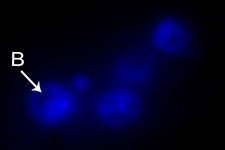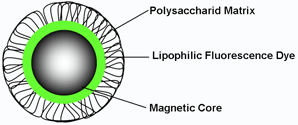
(Data kindly provided by Badr Haitham and Dr. Joerg Hoheisel DKFZ-Heidelberg, Germany)
nano-screenMAG - is an aqueous dispersion of magnetic-fluorescent nanoparticles available in hydrodynamic diameters of 100 nm, 150 and 200 nm.
nano-screenMAG particles consist of a magnetite core which is first covered by a lipophilic fluorescence dye. A second layer envelops the particle with a hydrophilic polymer which protects the particles against aggregation by foreign ions. Terminal functional groups such as ion-exchange groups or reactive groups for covalent immobilization can be used for binding to biomolecules.
 |
nano-screenMAG FluorescenceType |
Fluorescence Color | Excitation | Emission |
|---|---|---|---|---|
| nano-screenMAG/B | blue | 378 nm | 413 nm | |
| nano-screenMAG/G | green | 476 nm | 490 nm | |
| nano-screenMAG/O | orange | 524 nm | 539 nm | |
| nano-screenMAG/P | pink | 547 nm | 581 nm | |
| nano-screenMAG/R | red | 578 nm | 613 nm |
NOTE: The fluorescence of the nano-screenMAG particles is only detectable on the same side where the excitation takes place.
Please note that there is a difference in fluorescence observation between dissolved fluorescence molecules and solid fluorescence particles. Fluorescence spectrophotometer with a fluorescence detection unit with an angle of 90° to the excitation source will detect no or only weak fluorescence signals.
| Application: | Magnetic separation, labeling and fluorescence detection | |
| Concentration: | 25 mg/ml | |
| Particle sizes: | 100 nm, 150 nm, 200 nm; For ordering mention the fluorescence color | |
| Product | Polymer Matrix | Product Number | Quantity (ml) | Price EUR / USD |
Application | Product Information | Reference Number |
|---|---|---|---|---|---|---|---|
| nano-screenMAG-ARA | Glucuronic acid | 4415-1 4415-5 |
1 5 |
60 / 78 240 / 312 |
Weak cation exchanger; for covalent coupling of biomolecules (antibodies or
proteins) See protocol: A10 |
6.06, 6.13, 10.49 | |
| nano-screenMAG-Chitosan | Chitosan | 4418-1 4418-5 |
1 5 |
60 / 78 240 / 312 |
linear and biogradable polymer with amino-groups. | 6.03, 6.17, 10.47 | |
| nano-screenMAG-CMX | Carboxymethyl-dextran | 4406-1 4406-5 |
1 5 |
60 / 78 240 / 312 |
Weak cation-exchanger for covalent coupling of biomolecules (antibodies or proteins) See protocol: A11 |
6.03, 6.12 | |
| nano-screenMAG-D | Starch | 4401-1 4401-5 |
1 5 |
60 / 78 240 / 312 |
Isolation of lysosomes, MRI-diagnostic,
for covalent coupling of biomolecules (antibodies or proteins) See protocol: A9 |
6.02,
6.11,
6.16, 6.18, 10.44, 10.46 |
|
| nano-screenMAG-DEAE | DEAE-starch | 4402-1 4402-5 |
1 5 |
60 / 78 240 / 312 |
Binds negative groups of cells, bacteria, viruses | 4.15, 6.19 | |
| nano-screenMAG-DP | Phosphate-starch | 4403-1 4403-5 |
1 5 |
60 / 78 240 / 312 |
Purification of basic proteins, drug targeting | - | |
| nano-screenMAG-DXS | Dextran-sulfate | 4405-1 4405-5 |
1 5 |
60 / 78 240 / 312 |
Strong cation exchanger | - | |
| nano-screenMAG-Lipid | Lipid | 4419-1 4419-5 |
1 5 |
60 / 78 240 / 312 |
Negatively charged phosphatidylcholine | 4.15, 6.03, 6.16 | |
| nano-screenMAG-PAA | Polyaspartic acid | 4408-1 4408-5 |
1 5 |
60 / 78 240 / 312 |
Strong cation exchanger | - | |
| nano-screenMAG-PAD | Polyacrylamide | 4409-1 4409-5 |
1 5 |
60 / 78 240 / 312 |
Surface modification | - | |
| nano-screenMAG-PAS | Polyacrylic acid | 4410-1 4410-5 |
1 5 |
60 / 78 240 / 312 |
Weak cation-exchanger |
6.15 | |
| nano-screenMAG-PEA | Polydimethylamine | 4417-1 4417-5 |
1 5 |
60 / 78 240 / 312 |
Terminal amino groups for conjugation of biomolecules | - | |
| nano-screenMAG-PEG/P | Polyethylene glycol α-, ω-diphosphate | 4416-1 4416-5 |
1 5 |
60 / 78 240 / 312 |
Aqueous dispersion of polyethylene glycol α-, ω-diphosphate covered magnetic nanoparticles | - | |
| nano-screenMAG-PMO | Poly(maleic acid-co-olefin) | 4421-1 4421-5 |
1 5 |
60 / 78 240 / 312 |
For hydrophilic / hydrophobe interaction | 4.15 | |
| nano-screenMAG-PS | Polystyrenesulfonate | 4411-1 4411-5 |
1 5 |
60 / 78 240 / 312 |
Strong cation-exchanger | - | |
| nano-screenMAG-UC/A | Magnetite uncoated | 4414-1 4414-5 |
1 5 |
60 / 78 240 / 312 |
Adsorption of biomolecules stabilized by cross-linking; anionic charged | - | |
| nano-screenMAG-UC/C | Magnetite uncoated | 4430-1 4430-5 |
1 5 |
60 / 78 240 / 312 |
Adsorption of biomolecules stabilized by cross-linking; cationic charged | - |
nano-screenMAG-affinity - bioaffine ligands are covalently bound to the magnetic-fluorescent particles. High selectivity and high capacity make these products an ideal tool for the isolation or detection of specific biomolecules.
| Application: | Affinity chromatography and fluorescence detection | |
| Concentration: | 10 mg/ml | |
| Particle sizes: | 100 nm, 150 nm, 200 nm; For ordering mention the fluorescence color | |
| nano-screenMAG with Ligand | Product Number | Quantity (ml) | Price EUR / USD |
Application for: Purification / Binding | Product Information | Reference Number |
|---|---|---|---|---|---|---|
| nano-screenMAG-Biotin | 4501-1 4501-5 |
1 5 |
120 / 156 480 / 624 |
Avidin / streptavidin labeled molecules | - | |
| nano-screenMAG-Goat anti-mouse IgG (whole molecule) | 4502-1 4502-5 |
1 5 |
120 / 156 480 / 624 |
Secondary antibody See protocol: B5 |
- | |
| nano-screenMAG-Protein A | 4503-1 4503-5 |
1 5 |
120 / 156 480 / 624 |
Antibodies See protocol: B4 |
- | |
| nano-screenMAG-Protein G | 4504-1 4504-5 |
1 5 |
120 / 156 480 / 624 |
- | ||
| nano-screenMAG-Streptavidin | 4505-1 4505-5 |
1 5 |
120 / 156 480 / 624 |
Biotin-labeled molecules See protocol: B1 |
8.06 | |
| nano-screenMAG-Casein | 4506-1 4506-5 |
1 5 |
120 / 156 480 / 624 |
RNA polymerase | - | |
| nano-screenMAG-Gelatin | 4507-1 4507-5 |
1 5 |
120 / 156 480 / 624 |
Fibronectin | - | |
| nano-screenMAG-Heparin | 4508-1 4508-5 |
1 5 |
120 / 156 480 / 624 |
Lipoprotein, lipase, RNA-polymerase | - |
| Customized Coupling Service |
|---|
|
We can also couple a multitude of further bioaffine ligands, such as antibodies, proteins, peptides or oligonucleotides. We develop your special protocol and create complete kit solutions. |
